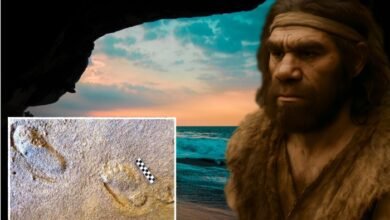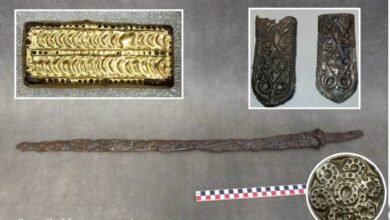1.5-Million-Year-Old Footprints Of Two Different Species Of Human Ancestors Found At The Same Spot

Jan Bartek – AncientPages.com – Over a million years ago, in a bustling savanna near the future site of Lake Turkana in Kenya, two distinct hominin species might have crossed paths while scavenging for food.
This conclusion comes from scientists who studied 1.5-million-year-old fossils they discovered, identifying them as the earliest known example of two sets of hominin footprints created around the same time on an ancient lakeshore. According to researchers, this finding offers valuable insights into human evolution and sheds light on how different species interacted through cooperation and competition.
An early member of our genus Homo left a single deep footprint as it slid its toes in the mud near where another type of hominin walked on the same day. Credit: Kevin G. Hatala
The discovery offers hard proof that various hominin species coexisted in both time and space, navigating the dangers of predators and the difficulties of obtaining food in ancient Africa. According to researchers, the tracks were made by hominins from the species Homo erectus and Paranthropus boisei, which were among the most prevalent human species during the Pleistocene Epoch.
“Hominin” is a term used to define a specific subgroup within the broader category of hominids. This group encompasses all organisms, both extinct and living, that are considered part of the human lineage following the evolutionary divergence from the ancestors of great apes. This split is estimated to have occurred approximately 6 million to 7 million years ago.
“Their presence on the same surface, made closely together in time, places the two species at the lake margin, using the same habitat,” said Craig Feibel, an author of the study and a professor in the Department of Earth and Planetary Sciences and Department of Anthropology in the Rutgers School of Arts and Sciences.
Feibel, who has been researching in northern Kenya since 1981—a region known for its rich fossil deposits—used his expertise in stratigraphy and dating to establish that the fossils date back 1.5 million years. He also analyzed the depositional environment of the footprint surface, determining that the track makers passed through within a few hours and created their prints directly on the soft sediments where they were discovered. According to Feibel, even if these hominins did not meet, they walked along the shore within hours of each other.
While skeletal fossils have traditionally been central to studying human evolution, new insights from fossil footprints shed light on fascinating aspects of human anatomical development and movement. These findings also provide additional clues about ancient human behaviors and environments, as noted by Kevin Hatala, an associate professor of biology at Chatham University in Pittsburgh, Pennsylvania, and the study’s lead author.
“Fossil footprints are exciting because they provide vivid snapshots that bring our fossil relatives to life,” said Hatala, who has been investigating hominin footprints since 2012.
“With these kinds of data, we can see how living individuals, millions of years ago, were moving around their environments and potentially interacting with each other, or even with other animals. That’s something that we can’t really get from bones or stone tools.”
Hatala, a specialist in foot anatomy, discovered that the species’ footprints exhibited varying patterns of anatomy and movement. Along with several co-authors, he utilized newly developed methods to differentiate one set of footprints from another. These innovative techniques allowed them to perform a detailed 3D analysis.
The team used advanced 3D imaging to view footprints in a new way, aiding our understanding of human evolution and the roles of cooperation and competition.
Feibel highlighted that it has long been theorized that these fossil human species coexisted. According to fossil records, Homo erectus, a direct ancestor of modern humans, survived for an additional million years. In contrast, Paranthropus boisei became extinct within the following few hundred thousand years, though the reasons remain unknown.
A member of the human family left a trail of footsteps on a muddy lakeshore about 1.5 million years ago in what is now Kenya. Credit: Neil T. Roach
Both species exhibited upright postures and bipedalism and were notably agile. However, there is limited information about their cultural and reproductive interactions during their coexistence.
The footprints are particularly important because they are classified as “trace fossils,” which include footprints, nests, and burrows. Unlike body fossils such as bones and teeth—which can be displaced by water or predators—trace fossils provide evidence of behavior without being part of the organism itself. Feibel emphasized that trace fossils remain in place where they were formed.
“This proves beyond any question that not only one, but two different hominins were walking on the same surface, literally within hours of each other,” Feibel said. “The idea that they lived contemporaneously may not be a surprise. But this is the first time demonstrating it. I think that’s really huge.”
The study was published in the journal Science
Written by Jan Bartek – AncientPages.com Staff Writer






